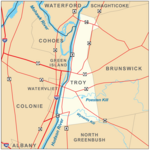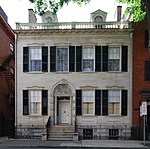Ohio Street Methodist Episcopal Church Complex

Ohio Street Methodist Episcopal Church Complex, also known as Third Avenue Methodist Church and St. Ann Maronite Catholic Church, is a historic Methodist Episcopal church at 1921 Third Avenue in Watervliet, Albany County, New York. It was originally built about 1850 and modified about 1895. The parish house was built about 1880. Both are brick buildings with wood floor and roof framing and stone foundations.It was listed on the National Register of Historic Places in 2005.In 2013 the church was renamed St. Ann Maronite Catholic Church as the 100 year old Maronite congregation, previously located on 4th Street in Troy brought the vacant Methodist Church Complex from the city of Watervliet.
Excerpt from the Wikipedia article Ohio Street Methodist Episcopal Church Complex (License: CC BY-SA 3.0, Authors, Images).Ohio Street Methodist Episcopal Church Complex
3rd Avenue,
Geographical coordinates (GPS) Address Phone number Website External links Nearby Places Show on map
Geographical coordinates (GPS)
| Latitude | Longitude |
|---|---|
| N 42.731091666667 ° | E -73.702938888889 ° |
Address
Saint Ann Maronite Catholic Church (Saint Ann Church;St. Ann Church)
3rd Avenue 1919
12189
New York, United States
Open on Google Maps








